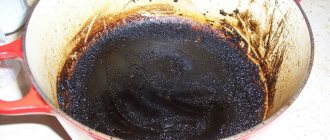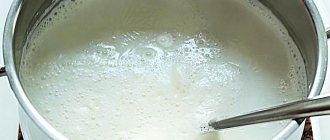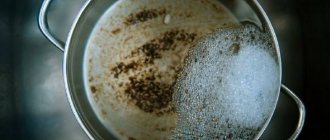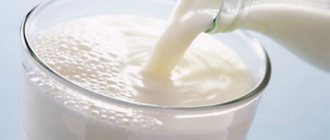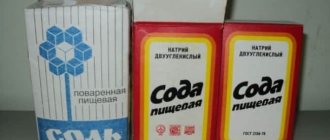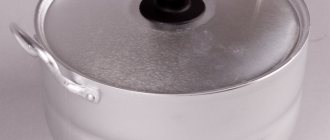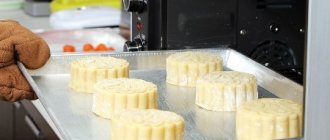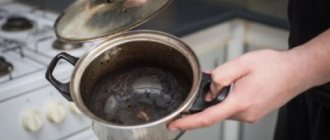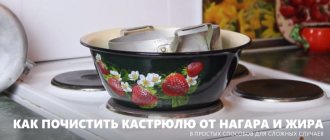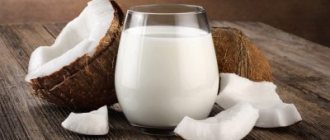Even the most experienced housewives make mistakes while cooking. Burnt milk inside the pan is one of the common problems in the kitchen. To wash dishes from burnt milk, use various means. The most important thing is to start cleaning as soon as dirt appears. How can I clean the pan?
Salt
Fill an aluminum or stainless steel pan with cold water and let it sit for 10-15 minutes. Then drain the water and fill the bottom with salt. After 2-3 hours, remove the salt from the dish and rub its inner surface with the hard side of the sponge. It is not necessary to use detergents. The enamel pan must first be removed from the stove and allowed to cool. Do not fill it with water immediately so that the enamel does not peel off. Then follow the steps described above. If carbon deposits remain, repeat the procedure again.
Boil correctly
To prevent milk from burning, it should be properly heated and boiled. Preference should be given to pans with a double bottom or special pans for milk with double walls. As the liquid heats up, stir constantly and remove any foam that has formed.
Boiling in the microwave
Boiling liquid in a microwave oven does not preserve all the useful elements. To heat whole cow's milk, it is better to choose a ceramic or glass container. You need to boil the milk for 3-6 minutes, using a gentle heating mode.
Vinegar
This method is more suitable for aluminum cookware. Pour vinegar into the pan, cover it with a lid and leave for 2 hours. Then drain the liquid and wash the dishes. Vinegar is good because in addition to burnt milk, it will also remove dark spots from aluminum products. It is better to fill enamel pans with a solution of vinegar and water.
Read also: How to clean frying pans made of different materials from carbon deposits?
Oven cleaning rules
Removing stains from a down jacket after washing
Errors when cleaning
Housewives often spoil dishes if they are not cleaned properly, so all that remains is to throw them away. Do not allow this outcome and remember what things you should never do:
- clean the enamel with metal meshes and coarse bristles. They will leave behind scratches, the coating will quickly become unusable;
- use washing powder or other products unsuitable for washing dishes. They can become firmly embedded in the surface, and during cooking penetrate into food and cause poisoning;
- use cleaning products with large abrasive particles. Just like hard metal brushes, they leave marks on the enamel.
If you are unsure how the product will react with the material, treat a small area first and wait time. If nothing happens to the coating, then feel free to apply the powder or gel to the entire area of contamination.
Soda
If the pan is damaged not only inside, but also outside, then it is better to boil it entirely in a soda solution. To do this, prepare a metal container of a larger volume than the affected dishes. Remove all plastic elements from the latter and prepare a solution at the rate of 500 g of soda per 5 liters of water. Place the dirty item in a container and fill it with solution. The liquid should completely cover the pan. Bring the water to a boil and leave on low heat for 2 hours. Remove the container from the heat, drain the liquid and wait until the pan dries. Then wash it with a sponge. This method is suitable for any pans.
You can also use a mixture of baking soda and salt. Fill the bottom of the dish with it and pour a small amount of warm water inside. The result should be a thick paste. Cover the pan with a lid and leave for a day. Then remove the mixture and boil plain water in a saucepan. Wash the product. This method is not suitable for stainless steel cookware as stains may appear on its surface.
Features of cleaning pots made of different materials
The material from which the cookware is made affects operation and cleaning.
Enameled
Carbon deposits are easily washed off the enamel. Therefore, they do without chemicals, salt and other aggressive agents. It’s better to just wash it with dish gel, and when that doesn’t help, boil it with soda. It is not advisable to rub the enamel too much - it will rust.
Stainless steel
Stainless steel is also quite easy to clean. The material can be rubbed with abrasives, but only with fine-grained ones:
- do not use powders with large crystals (salt, citric acid, powdered “Shumanit”);
- wash with a soft kitchen sponge;
- It’s better not to boil – it doesn’t spoil the stainless steel, but it does darken it.
Made of aluminum
Aluminum heats up quickly and the milk boils in a couple of minutes. But it burns almost immediately after boiling. Therefore, you need to constantly monitor the milk in an aluminum pan and turn off the gas in time. If the liquid still burns, then the aluminum is cleaned according to the following rules:
- wipe only with a soft cloth or sponge;
- do not use acids - they cause the metal to become covered with dark spots.
Non-stick coating
These pans, as you might expect, rarely burn. Milk deposits will only appear if you forgot to turn off the gas and the milk takes a long time to boil away. Carbon deposits can be cleaned off quite easily, but with 2 conditions:
- wipe the walls and bottom of the pan only with a soft dish sponge;
- Do not use bulk products - scratches will damage the coating.
Lemon acid
Prepare a solution: 30 g of citric acid per 5 liters of water. Pour it into the pan and put it on the fire. Boil for about 1 hour. Drain the solution and wash the dishes. The method is only suitable for enamel pans.
If you don’t want to soak dishes for a long time and prepare cleaning products yourself, then buy a special preparation. In modern hardware stores, such products are presented in a wide range. Before purchasing, consult with the seller and read the manufacturer's recommendations.
What is better not to do
| Ban | Description |
| Boil milk in an enamel bowl | It was said above that plaque is easily washed off from the enamel. But it appears - also much easier than in other types of pans. If you have to clean the pan often, the enamel will wear off, even if you're careful. |
| Leave carbon deposits in the pan | When it's burnt, you need to clean it right away. If you cook food in a pan stained with carbon deposits, the thermal effect will cause it to “take root” deeper and become impossible to remove. |
| Pouring aggressive chemicals inside | It is better to use chemicals only to clean the outside of the pan. A small amount of the product risks remaining on the walls of the dishes and getting into the food, which is unsafe. |
| Rub with a metal brush | A pan made of any material does not withstand the impact of a wire brush. Wide scratches remain in which microparticles of food get stuck and give the pan an unpleasant odor. |
Burnt oil, fat
To remove fat deposits remaining on the surface after cooking, a paste of laundry soap and soda is suitable, applied to the problem area in a thick layer.
Any complex stains can be effectively dealt with using folk remedies, which are found in every home. If you don’t have time and have the desire to quickly deal with the fumes, it is recommended to use any chemical product sold in specialized retail chains. The article provides detailed information on how to clean a burnt pan without harming its surface.
Care Tips
Enameled cookware will last for many years if you care for it properly. If you take care, it will always shine clean. To do this, remember a few tips:
- Do not cook milk soups in an enamel pan, do not use it to heat milk. Burnt product is difficult to introduce;
- If you recently bought a saucepan and have not used it yet, fill it with water and boil for 20 minutes before cooking. This will harden the material;
- Choose a burner size for dishes of the appropriate diameter. If you place a large dish on a small burner, heating will occur unevenly, which means cracks will soon form on the coating;
- Wash the pan every time after cooking with lemon juice or acetic acid. They will remove a small coating;
- Do not place hot dishes in the refrigerator or on the balcony at low temperatures. Enamel does not tolerate sudden temperature changes;
- handle the utensils with care: after use, wash them, wipe them dry and put them in a closet for storage. Rust should not be allowed to form as it gets into the food during cooking. Moreover, if handled carelessly, chips and cracks appear on the surface.
If you start cleaning in a timely manner using any of the proposed methods, your pan will be saved. In the future, never leave dishes unattended on the stove while it is on to avoid trouble. With proper care, an enameled product will serve you for decades.
Removing the burnt inside: sequence of actions
Tableware enamel requires special treatment. Therefore, before directly cleaning a burnt pan, you need to perform the following steps:
- The fight against carbon deposits cannot be postponed until later. Otherwise, it will be extremely difficult to wash it completely. Therefore, as soon as the pan is burnt, the dish must be placed in another dish; this can be done at any stage of cooking.
- Determine the type of coverage. If it is glossy, then you can start resuscitating it immediately. If it is matte, then the container should be cooled first. Glossy enamel is more durable and easily tolerates temperature changes. For a matte finish, a sudden change in temperature is detrimental.
- You should not try to clean the carbon deposits without soaking. An ordinary sponge will not do this, and metal dish brushes will damage even the most durable enamel. At first, barely noticeable scratches will appear on it, then cracks, and then chips. The soot is generously sprinkled with table salt, soda or filled with dishwashing gel, pour a little hot water into the container and wait for several hours (preferably 8-10).
- When the specified time has elapsed, boil the solution of salt, soda or gel for about a quarter of an hour, cool and clean the container from sticking with a foam sponge. If the desired effect cannot be achieved, additional cleaners will be required.
Tags
and the milk burns hand milk something to milk do not pour milk not and milk do not boil milk stove. Milk should be Stored milk should be Pasteurized milk should be boiled Boiled milk should be Boiled or be sure to boil unpasteurized How long to boil milk should be boiled for milk boil non-material. Boil milkmilk needs to be removedHere you need to watch the boiling of milk is created
boil the product cookware aluminum will be minutes tips be useful unpleasant will burn store temperature correctly enameled necessarily sugar vitamins bacteria shelters storage recipe store hardening for example some cooker stoves refrigerator
Compliance with safety regulations
To avoid harm to your health, take care of your safety and follow the safety rules:
- use durable rubber gloves even when working with mildly aggressive substances;
- pour loose powders in small portions so that dust does not scatter throughout the house;
- when working with caustic substances, wear a respirator, open the vents and windows in the house, and even better, clean in the open air;
- When cleaning, cover all parts of your body: wear pants, sweaters with arms, socks. Do not allow chemicals to come into contact with the skin;
- Once the surface is clean, rinse the pan with water repeatedly. To be more convincing, boil a couple of liters of water in a container for half an hour. You can add lemon juice, it neutralizes the remaining chemical elements.
If you follow the advice, you will definitely not have any problems during processing. If you are distracted and accidentally allow household chemicals to come into contact with your skin, immediately wash it off with water.
If the skin at the site of contact with the chemical becomes very red and causes pain, you should consult a doctor.
Why does food burn in pans while cooking?
Even in expensive pans, food can burn. A common cause is considered to be insufficient liquid added during the cooking process. Therefore, cooks recommend monitoring the presence of water, broth, oil, and sauce in the container.
A multicooker is also no exception - careful care of the inner surface of the bowl does not prevent water from boiling away if there is not enough water and food sticking to the bottom.
Before cleaning a product from burning, you should determine what material it is made of. Each coating will react differently to the cleaning composition. It is not recommended to clean stainless steel surfaces with salt; enamel bases are resistant to acid; aluminum alloys are resistant to soda.
The method for cleaning a pan depends on its material.
Chemicals – quick removal of contaminants
You can clean dishes from stains caused by burnt milk using household chemicals. They are offered by manufacturers in a huge variety for different types of kitchen utensils. Before using them, you must study the instructions.
In most cases, the selected product is applied to the surface of the dishes using a sponge and left for the specified time. After that, traces of burnt milk can be easily removed by simply washing under running water. Modern high-quality chemicals are highly effective. With their help, the most difficult stains can be easily and quickly removed.
Attention! All manipulations to remove contaminants from burnt milk on pans when using household chemicals must be carried out with gloves.
Even if it happens that the milk in the pan burns, you should not be upset. There are many ways to clean stains and restore the attractive appearance of dishes. Moreover, most improvised means are absolutely harmless and are always at hand.
